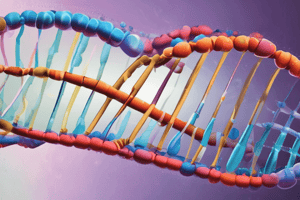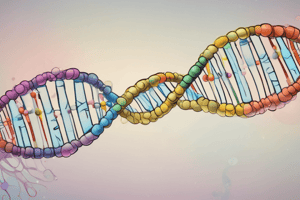Podcast
Questions and Answers
The leading and the lagging strands differ in that?
The leading and the lagging strands differ in that?
- The lagging strand is synthesized in the same direction as the movement of the replication fork.
- The leading strand is synthesized in the opposite direction of the replication fork.
- The lagging strand is synthesized in opposite direction of the movement of the replication fork. (correct)
- The leading strand is synthesized in the same direction as the movement of the replication fork. (correct)
What does a space probe return with?
What does a space probe return with?
- A sample of soil
- A culture of a microorganism found on a distant planet. (correct)
- Data about atmospheric compositions
- None of the above
In the late 1950s, what did Meselson and Stahl grow in a medium containing 'heavy' nitrogen (15N)?
In the late 1950s, what did Meselson and Stahl grow in a medium containing 'heavy' nitrogen (15N)?
- S. pneumoniae
- A virus
- Yeast
- E. coli bacteria (correct)
What type of genetic material does the tobacco mosaic virus have?
What type of genetic material does the tobacco mosaic virus have?
What forms during DNA replication due to a transient exposure to radioactive nucleotides?
What forms during DNA replication due to a transient exposure to radioactive nucleotides?
What did biologists know about the nucleus for a couple of decades?
What did biologists know about the nucleus for a couple of decades?
The DNA double helix has a uniform diameter because ___, which have two rings, always pairs with ___, which have one ring.
The DNA double helix has a uniform diameter because ___, which have two rings, always pairs with ___, which have one ring.
What must be done to the living cells in the modified Hershey and Chase experiment?
What must be done to the living cells in the modified Hershey and Chase experiment?
Which enzyme catalyzes the elongation of a DNA strand?
Which enzyme catalyzes the elongation of a DNA strand?
What is the role of DNA ligase during DNA replication?
What is the role of DNA ligase during DNA replication?
What do the descendants of heat-killed, phosphorescent bacteria reveal?
What do the descendants of heat-killed, phosphorescent bacteria reveal?
Which proteins help to hold the DNA strands apart during replication?
Which proteins help to hold the DNA strands apart during replication?
What occurs in a eukaryotic cell lacking telomerase?
What occurs in a eukaryotic cell lacking telomerase?
Why is the new DNA strand complementary to the 3' to 5' strands assembled in short segments?
Why is the new DNA strand complementary to the 3' to 5' strands assembled in short segments?
In a nucleotide, the nitrogenous base is attached to the sugar's ____
In a nucleotide, the nitrogenous base is attached to the sugar's ____
Hershey and Chase used ___ to radioactively label the T2 phage's proteins.
Hershey and Chase used ___ to radioactively label the T2 phage's proteins.
The spontaneous loss of amino groups from adenine results in what?
The spontaneous loss of amino groups from adenine results in what?
What does a biochemist isolate and purify for DNA replication?
What does a biochemist isolate and purify for DNA replication?
What happens to a eukaryotic cell lacking active telomerase?
What happens to a eukaryotic cell lacking active telomerase?
In his work with pneumonia-causing bacteria and mice, what did Griffin find?
In his work with pneumonia-causing bacteria and mice, what did Griffin find?
Why does a new DNA strand elongate only in the 5' to 3' direction?
Why does a new DNA strand elongate only in the 5' to 3' direction?
What synthesizes short segments of RNA?
What synthesizes short segments of RNA?
Why are individuals with xerodermia pigmentosum hypersensitive to sunlight?
Why are individuals with xerodermia pigmentosum hypersensitive to sunlight?
What happens when phage with labeled proteins or DNA infects bacteria?
What happens when phage with labeled proteins or DNA infects bacteria?
Which of the following statements does not apply to the Watson and Crick model of DNA?
Which of the following statements does not apply to the Watson and Crick model of DNA?
What did Chargaff's analysis of the base composition of DNA show?
What did Chargaff's analysis of the base composition of DNA show?
What does replicating the lagging strand of DNA involve?
What does replicating the lagging strand of DNA involve?
What is the function of DNA polymerase?
What is the function of DNA polymerase?
In an analysis of the nucleotide composition of DNA, which of the following is true?
In an analysis of the nucleotide composition of DNA, which of the following is true?
What is the difference between ATP and the nucleotides triphosphates used during DNA synthesis?
What is the difference between ATP and the nucleotides triphosphates used during DNA synthesis?
Flashcards are hidden until you start studying
Study Notes
DNA Replication and Structure
- Leading strand synthesizes in the same direction as the replication fork; lagging strand synthesized in the opposite direction.
- DNA double helix maintains a uniform diameter due to pairing of purines (two rings) with pyrimidines (one ring).
- DNA polymerase catalyzes the elongation of the DNA strand in the 5' to 3' direction.
- New DNA strand forms in short segments (Okazaki fragments) on the lagging strand because DNA polymerase only adds nucleotides to the free 3' end.
- DNA ligase joins Okazaki fragments together during replication, ensuring a continuous strand.
Molecular Components and Enzymes
- Tobacco mosaic virus contains RNA as its genetic material instead of DNA.
- Single-strand binding proteins hold DNA strands apart during replication to prevent re-annealing.
- Nucleotides consist of a sugar, phosphate group, and nitrogenous base; the base is attached to the sugar’s 1' carbon and the phosphate group to the 5' carbon.
Experiments and Findings
- Hershey and Chase used radioactive sulfur-35 to label proteins in the T2 phage, highlighting the genetic material's role.
- Meselson and Stahl's experiment differentiated DNA using heavy nitrogen (15N) versus light nitrogen (14N) to confirm semi-conservative replication.
- Griffith's experiments demonstrated that a non-pathogenic strain of bacteria could become pathogenic when mixed with heat-killed pathogenic strains.
Effects of Genetic Disorders
- Individuals with xeroderma pigmentosum have impaired ability to repair thymine dimers, causing hypersensitivity to sunlight.
- A eukaryotic cell without telomerase gradually reduces chromosome length after each replication cycle.
Key Principles and Observations
- Chargaff’s rules indicate that the amounts of adenine equal thymine and cytosine equal guanine in DNA.
- Certain amino acids contain nitrogen atoms, posing challenges in distinguishing between DNA and protein in experimental setups.
Summary of DNA Synthesis and Composition
- Differences between ATP and nucleotides used in DNA synthesis involve sugar types: deoxyribose in nucleotides and ribose in ATP.
- Nucleotides are essential for DNA replication; DNA polymerase functions to add these nucleotides to the growing DNA strand.
Studying That Suits You
Use AI to generate personalized quizzes and flashcards to suit your learning preferences.




